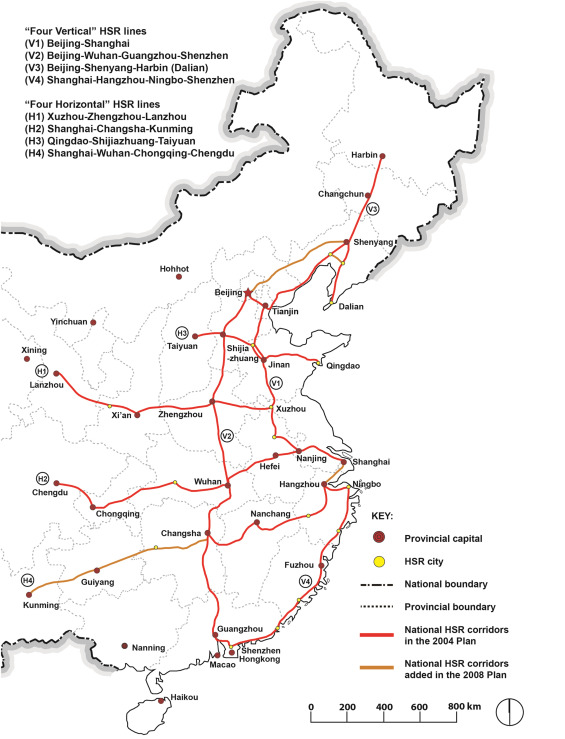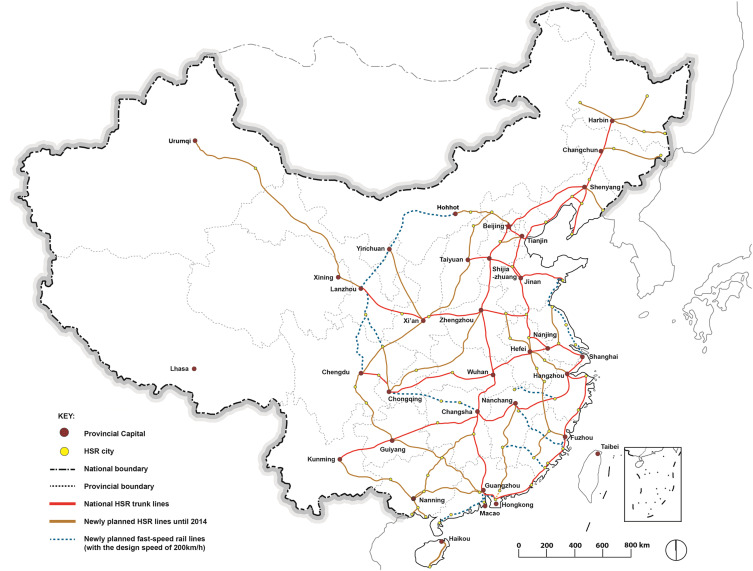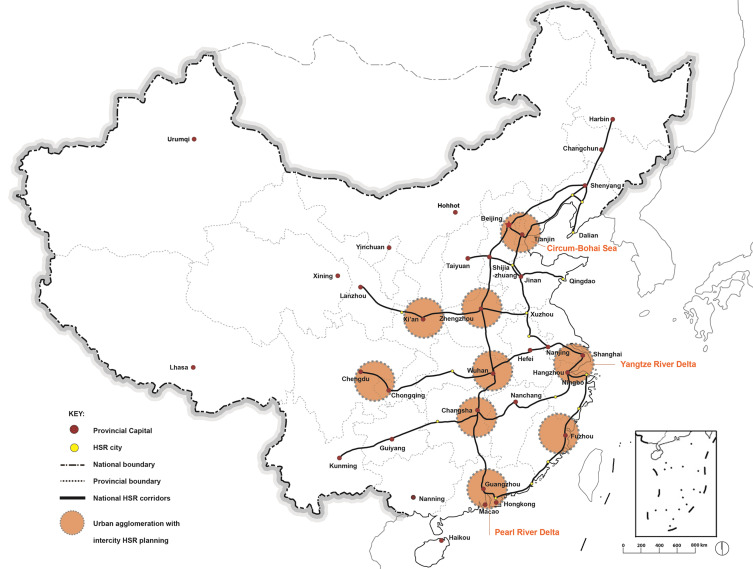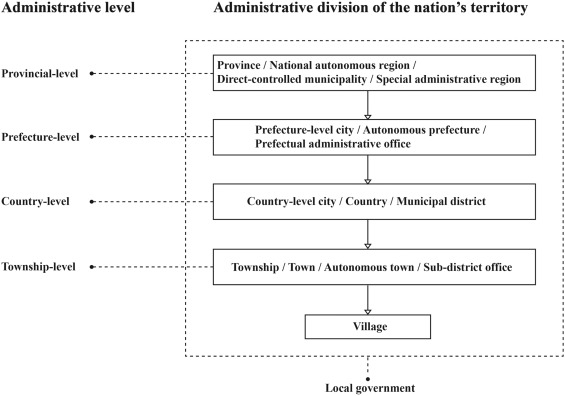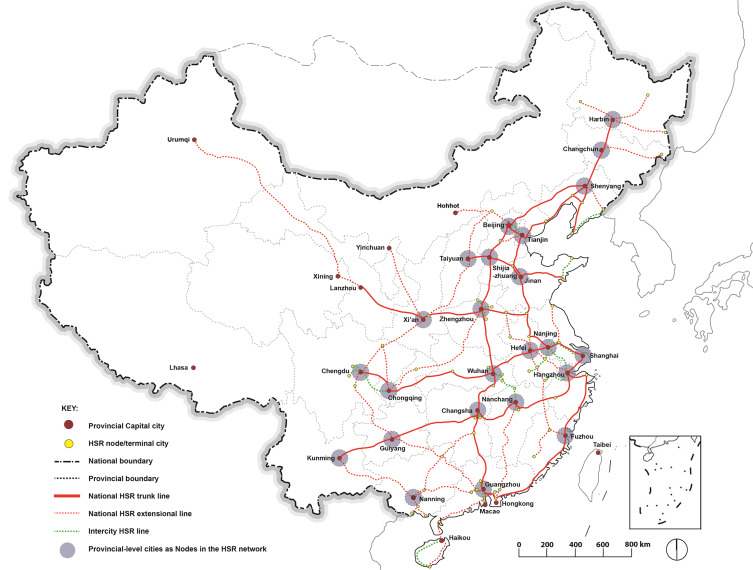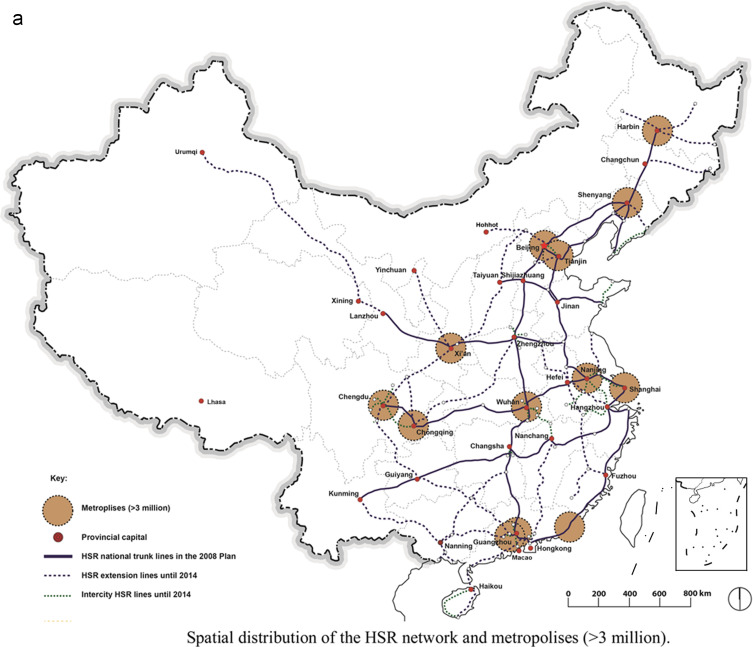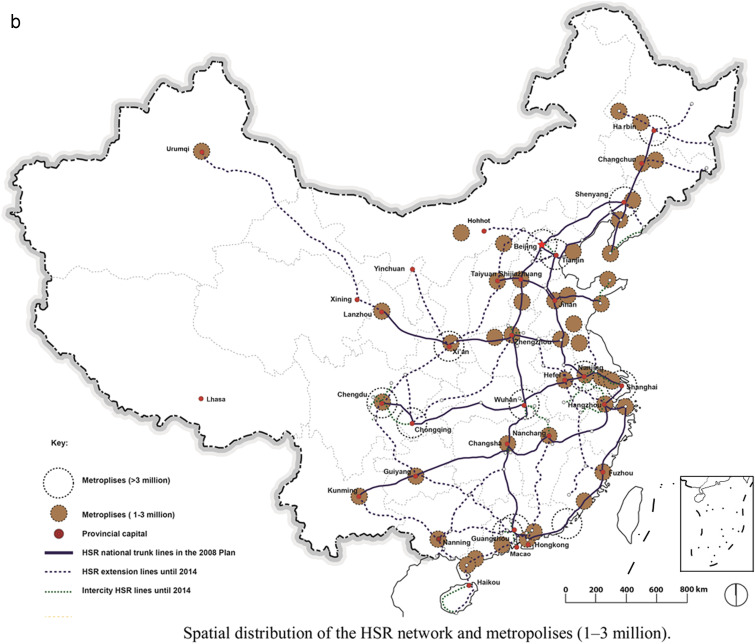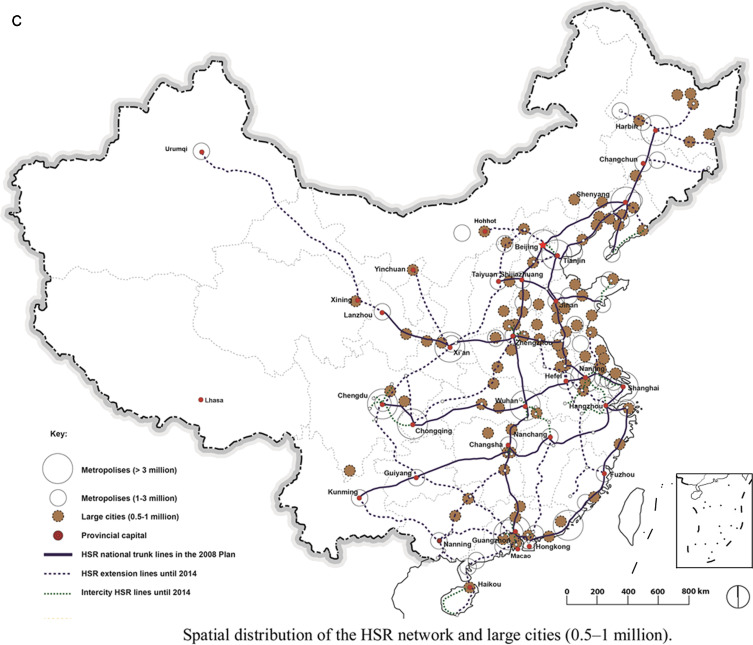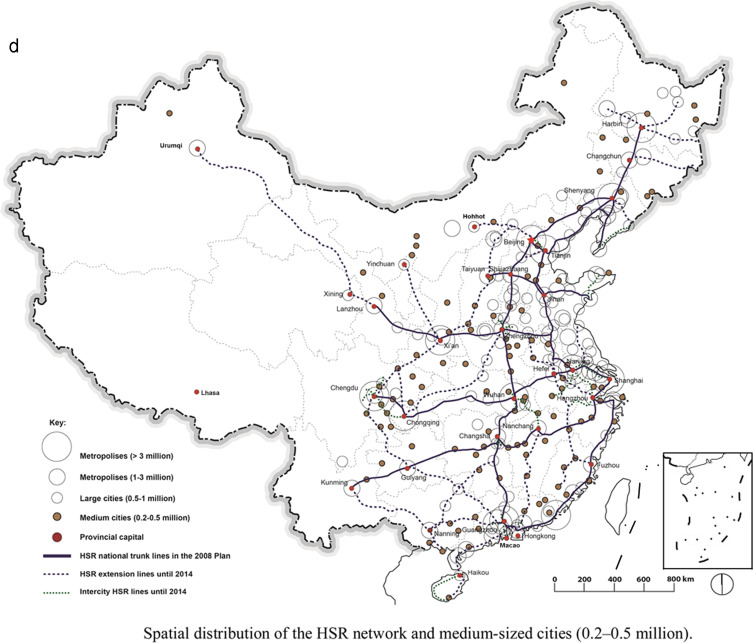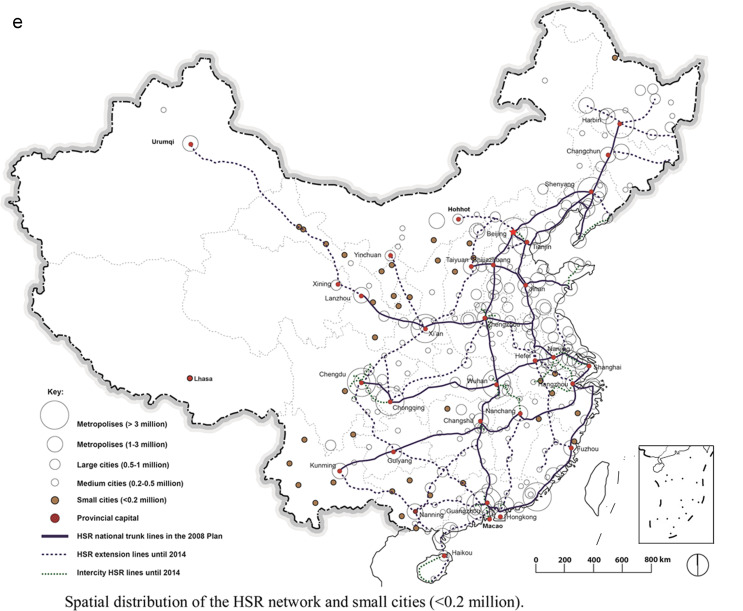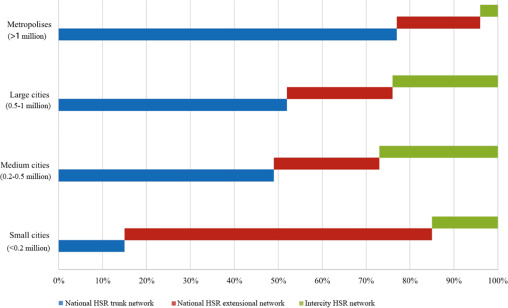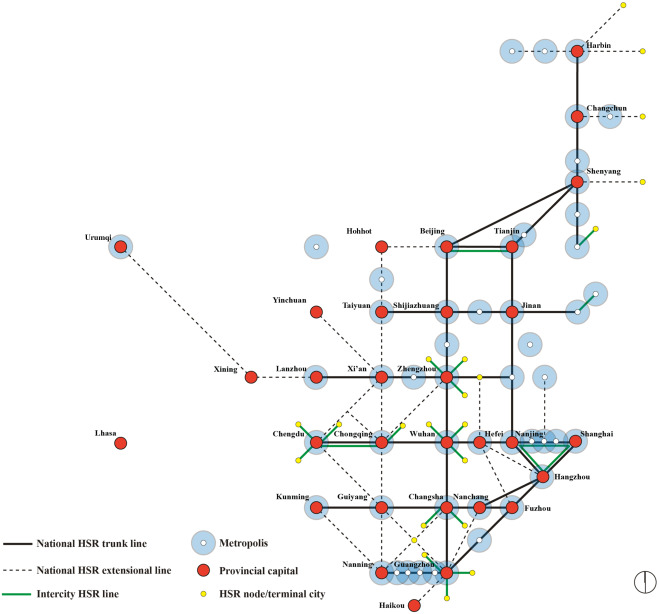Abstract
This study examines the interrelatedness between the hierarchical structure of China׳s urban system and high-speed railway (HSR) network planning at the national level. As a multi-layered system, the Chinese HSR can be categorized into three sub-networks, namely, the national HSR trunk network, the national HSR extensional network, and the intercity HSR network. By examining the direct HSR network connection, HSR nodal connection, and HSR operational frequency of 287 prefecture-level cities, this study demonstrates that the hierarchies of China׳s administrative, demographic, and economic urban systems strongly influence HSR network planning. The national HSR trunk network prioritizes the connection of top-level central cities, whereas the extensional network prioritizes cities at the lower level of the urban system. Moreover, the national HSR system forms the backbone of the HSR network structure based on a national scale, whereas the intercity HSR system satisfies the travel needs within urban agglomerations based on the regional level.
Keywords
National high-speed railway trunk network ; National high-speed railway extensional network ; Intercity high-speed railway network ; Hierarchical urban system ; Network planning ; China
1. Introduction
Hierarchy is an essential phenomenon in transport networks. Immers et al. (2004) stated that hierarchical transport networks result from the interaction between the demand and supply of the transport system. In the long run, the highly intensive usage of some routes can lead to improved facilities and investments, while the less used routes become neglected. In this way, the hierarchy of the network is continuously strengthened. Immers et al. argued that the railway networks developed in the early 19th century accelerated the hierarchical development of transport networks and spatial structures. Wang et al. (2012) suggested that each transport mode has its own network hierarchies, which depend on the territorial scales and other natural and social factors in a particular country.
Hierarchical transport networks are embedded in the hierarchy of urban networks. Several scholars have investigated the close interrelationships between these two systems. The pioneering study of Haggett et al. (1977) revealed that transport network development is an evolutionary process resulting from the substitution of routes among successively higher-order centers and the emergence of an urban hierarchy. Van Nes (2002) showed that the hierarchy in transport network levels is closely linked to that in settlements, and that each transport network level connects cities of a specific rank to higher-ranking cities. Immers et al. (2004) suggested that when planning an ideal transport network, one should first define how many and which cities should be incorporated in such network and in what order of importance. Although the abovementioned studies provide clear insights about the hierarchy phenomenon, transport networks must be investigated along with the existing hierarchical structure of urban systems to understand the logical structure of transport systems.
Regarded as the “transport modes of the future” (UIC, 2010 ), high-speed rail (HSR) networks are rapidly expanding in many countries. A long-term national HSR network was enthusiastically planned and implemented in China over the past decade. From 2004 to 2014, more than 11,000 km of new HSR routes were utilized for service.1 By 2020, the Chinese HSR network is expected to reach approximately 18,000 km, which accounts for more than half of the overall length of HSRs worldwide (Zhang and Nie, 2010 ). However, compared with such an unprecedented HSR network expansion, the hierarchical structure of China׳s HSR network planning remains a “black box” (Graham and Marvin, 2003 ). Only few studies have investigated the interrelatedness between Chinese HSR network planning and urban hierarchies, especially at the national level (e.g., Wang and Long, 2009 ; Wang and Jiao, 2014 ). The majority of existing research focuses on how HSR improves the accessibility of hub cities or changes the spatiotemporal structure of urban agglomerations. In other words, HSR is only of peripheral interest and serves as a tool to analyze the urban system.
This study, which focuses on the interrelatedness between HSR network planning and urban system, considers the opposite. It investigates the hierarchical urban network that is spatially linked by the HSR system to reveal the embedded rationalities of the hierarchical HSR network planning of China. Accordingly, this research aims to answer the following fundamental question: What are the roles of the urban system in the formation of the Chinese hierarchical HSR network?
Several research methods are adopted to answer this question. First, while HSR network planning belongs to the transport engineering domain, the urban system is the product of political, economic, and social developments and involves a group of complex and overlapping subjects. A multi-disciplinary method must be applied to investigate such ubiquitous dichotomy. Second, this research is also case-based. Given its large territories, China has coexisting multi-layers of HSR transport networks and urban networks, which provide an excellent opportunity to explore the interaction mechanism between these systems. Third, mapping is performed to bridge these systems and to represent, understand, and visualize their spatial structures. When these systems overlap on the same scale, their spatial relationships can be observed intuitively, thereby providing a direct entry point for further analysis.
The rest of this paper is structured as follows. First, Section 2 focuses on HSR network planning at the national level. Three HSR sub-categories are investigated, namely, the national HSR trunk network, the national HSR extensional network, and the intercity HSR network. Section 3 analyzes the urban systems that are linked by the HSR from the administrative, demographic, and economic perspectives. Section 4 explains how the Chinese urban system affects the formation of the hierarchical HSR system.
2. HSR network planning in China
The planning of China׳s HSR system commenced in the early 1990s, with the proposal to build the HSR line between Beijing and Shanghai in 1990 being one of the earliest attempts to construct an HSR system.2 Since then, numerous feasibility studies and debates have focused on the development of an HSR network in China. After more than 10 years of preparation, the State Council of China approved the Mid-to-Long Term Railway Development Plan in 2004, and then revised the same plan in 2008.3 Given that all relevant working programs of HSRs are subsequently compiled to implement this central policy, the Mid-to-Long Term Railway Development Plan is considered the most important guide to HSR development in China (Wang and Zhou, 2008 ). In this Plan, the expansion of HSR networks was scheduled as a long-range development process to be terminated in 2020. The Plan divided the Chinese HSR network into two major parts, namely, the national grid of passenger-dedicated lines (national HSR) and the regional passenger-dedicated lines (intercity HSR). The national HSR can be further divided into trunk and extensional networks.
Figure 1 illustrates the national HSR trunk network in the 2004–2008 Plan. The national HSR trunk grid comprises eight HSR trunk lines (i.e., four lines running north–south, and four lines going east–west). These lines are also known as the “Four Vertical” and “Four Horizontal” lines respectively.
|
|
|
Figure 1. National HSR trunk lines in the Mid-to-Long Term Railway Development Plan. Source : Elaborated by the author based on the map from the Mid-to-Long Term Railway Development Plan (2008 version). |
Three of the Four Vertical lines (Beijing–Shanghai, Beijing–Guangzhou, and Shanghai–Shenzhen HSR) form a triangle that links the three most important economic zones of China, namely, the Circum–Bohai Sea, Yangtze River Delta, and Pearl River Delta Economic Zone. The Beijing–Harbin HSR incorporates the northeast part of China into the HSR network. The Four Horizontal lines, which are roughly parallel with one another, penetrate from the more developed eastern regions to the less developed central and west regions. The distances between these four lines are approximately 300–500 km, thereby forming a relatively homogeneous east–west HSR grid. The total length of the eight HSR trunk lines is 13,327 km, 78% of which (10,389 km) have been utilized as of the end of 2014 (Table 1 ).
| Name of the HSR line | Constituent sections | Designed speed (km/h) | Length (km) | Construction start date | Open date |
|---|---|---|---|---|---|
| Beijing-Harbin | Beijing-Shenyang | 350 | 684 | 2014.02 | 2019 |
| Harbin-Dalian | 350 | 904 | 2007.08 | 2012.12 | |
| Panjin-Yingkou | 350 | 89 | 2009.05 | 2013.09 | |
| Beijing-Shanghai | Beijing-Shanghai | 350 | 1302 | 2008.04 | 2011.06 |
| Hefei-Bengbu | 350 | 131 | 2008.01 | 2012.10 | |
| Beijing-Wuhan-Guangzhou-Shenzhen | Beijing-Shijiazhuang | 350 | 281 | 2008.10 | 2012.12 |
| Shijiazhuang-Wuhan | 350 | 838 | 2008.10 | 2012.12 | |
| Wuhan-Guangzhou | 350 | 968 | 2005.09 | 2012.09 | |
| Guangzhou-Shenzhen | 350 | 116 | 2008.08 | 2009.12 | |
| Hangzhou-Fuzhou-Shenzhen | Hangzhou-Ningbo | 350 | 152 | 2009.04 | 2013.07 |
| Ningbo-Taizhou-Wenzhou | 250 | 268 | 2005.10 | 2009.09 | |
| Wenzhou-Fuzhou | 250 | 298 | 2005.01 | 2009.09 | |
| Fuzhou-Xiamen | 250 | 275 | 2005.10 | 2010.04 | |
| Xiamen-Shenzhen | 250 | 502 | 2007.11 | 2013.12 | |
| Qingdao-Taiyuan | Qingdao-Jinan | 250 | 364 | 2007.01 | 2008.12 |
| Jinan-Shijiazhuang | 250 | 319 | 2014.03 | 2017 | |
| Shijiazhuang-Taiyuan | 250 | 190 | 2005.06 | 2009.04 | |
| Xuzhou-Lanzhou | Xuzhou-Zhengzhou | 350 | 357 | 2012.12 | 2016 |
| Zhengzhou-Xi’an | 350 | 455 | 2005.09 | 2010.02 | |
| Xi’an-Baoji | 350 | 148 | 2009.11 | 2013.12 | |
| Baoji-Lanzhou | 350 | 403 | 2012.10 | 2017 | |
| Shanghai-Wuhan-Chengdu | Shanghai-Nanjing | 350 | 301 | 2008.07 | 2010.07 |
| Nanjing-Hefei | 250 | 166 | 2005.06 | 2008.04 | |
| Hefei-Wuhan | 250 | 351 | 2005.08 | 2009.04 | |
| Wuhan-Yichang | 250 | 293 | 2008.08 | 2012.07 | |
| Yichang-Lichuan | 200 | 377 | 2003.12 | 2010.12 | |
| Lichuan-Chongqing | 200 | 264 | 2008.12 | 2013.12 | |
| Chongqing-Suining | 200 | 132 | 2009.01 | 2012.12 | |
| Suining -Chengdu | 200 | 148 | 2005.05 | 2009.06 | |
| Shanghai-Kunming | Shanghai-Hangzhou | 350 | 150 | 2009.02 | 2010.10 |
| Hangzhou-Changsha | 350 | 926 | 2009.12 | 2014.12 | |
| Changsha-Kunming | 350 | 1175 | 2010.03 | 2016 | |
| Total | − | − | 13,327 | − | − |
However, planning the eight national HSR trunk corridors was not the end of the story. After the 2008 World Financial Crisis, the Chinese government proposed the “Four Trillion (RMB) Stimulus Program,” which further reinforced investments on the HSR system (Wang et al., 2012). Since then, the Chinese national HSR network was expanded aggressively. Table 2 shows that more than 9743 km of HSR lines have been newly developed in the country, of which 4210 km (43.2%) have been utilized as of the end of 2014.
| Name of the HSR line | Sections | Designed speed (km/h) | Length (km) | Construction start date | Open date |
|---|---|---|---|---|---|
| Tianjin-Shenyang | Tianjin-Qinhuangdao | 350 | 261 | 2008 | 2013.12 |
| Qinhuangdao-Shenyang | 250 | 404 | 1999 | 2003.07 | |
| Guangxi Coastal | Nanning-Qinzhou | 250 | 99 | 2008.12 | 2013.12 |
| Qinzhou-Fangchenggang | 250 | 63 | 2009.06 | 2013.12 | |
| Qinzhou-Beihai | 250 | 100 | 2009.06 | 2013.12 | |
| Chengdu-Guangzhou | Chengdu-Guiyang | 250 | 633 | 2013.12 | 2019 |
| Guiyang-Guangzhou | 300 | 857 | 2008.10 | 2014.12 | |
| Datong-Xi’an | Datong-Taiyuan | 250 | 209 | 2004.08 | 2016 |
| Taiyuan-Xi’an | 250 | 650 | 2009.12 | 2014.07 | |
| Tianjin-Baoding | − | 250 | 158 | 2010.09 | 2015 |
| Beijing-Zhangjiakou | − | 250 | 173 | 2015 | 2018 |
| Zhangjiakou-Hohhot | − | 250 | 286 | 2014.05 | 2018 |
| Zhangjiakou-Datong | − | 250 | 137 | 2015 | 2018 |
| Lanzhou-Hami-Urumqi | − | 300 | 1776 | 2010.03 | 2014.12 |
| Hefei-Fuzhou | − | 350 | 808 | 2009.12 | 2015 |
| Xi’an-Chengdu | − | 250 | 643 | 2012.10 | 2018 |
| Chengdu-Guiyang | − | 250 | 632 | 2013.12 | 2019 |
| Kunming-Nanning | − | 250 | 710 | 2009.12 | 2015 |
| Jilin-Hunchun | − | 250 | 359 | 2010.10· | 2015 |
| Zhengzhou-Wanzhou | − | 250 | 785 | 2015 | − |
| Total | − | − | 9,743 | − | − |
Figure 2 shows the spatial distribution of national HSR trunk lines, the newly planned HSR lines, and the fast-speed rail lines.4 Spatially, the newly planned HSR lines can be regarded as branches and extensions of the trunk lines or the linking lines among trunk lines. Therefore, we consider these newly planned HSR lines as the national HSR extensional lines.
|
|
|
Figure 2. Extension of the national high-speed railway network until 2014. Source : Elaborated by the author. |
Another product of aggressive planning, the intercity HSR system refers to those HSR lines that are designed to connect a group of cities within integrated metropolitan areas. In the 2004 Plan, the intercity HSR system was only planned to be located in the three most important urban agglomerations in China, namely, Circum–Bohai Sea, Yangtze River Delta, and Pearl River Delta. However, in the 2008 Plan, the number of agglomerations with intercity HSR plans increased to nine (Figure 3 ). Although the nine urban agglomerations only account for 18.4% of the national territory, their populations account for nearly 54.8% of the total and their GDPs account for 76.7% of the national output (Table 3 ). Therefore, the planned intercity HSR system is located within urban agglomerations where the population, economic, and social activities of the country are most concentrated.
|
|
|
Figure 3. Nine urban agglomerations with intercity HSR planning. Source: Elaborated by the author. |
| Name of urban agglomeration | Prefecture-level cities or above | Size (10,000 km2) | Population (one million) | GDP (10 million Yuan) |
|---|---|---|---|---|
| Circum-Bohai Sea | 44 | 52.3 | 230.4 | 77,564.7 |
| Yangtze River Delta | 30 | 16.6 | 150.0 | 69,522.1 |
| Pearl River Delta | 31 | 18.0 | 95.4 | 35,696.5 |
| Chang-Zhu-Tan | 3 | 2.8 | 13.2 | 4,565.3 |
| Cheng-Yu | 22 | 56.8 | 111.0 | 17,602.9 |
| Zhongyuan | 8 | 4.4 | 35.3 | 8,814.5 |
| Wuhan | 9 | 5.8 | 31.7 | 3,132.9 |
| Guanzhong | 6 | 8.0 | 25.4 | 4,461.1 |
| Fujian | 9 | 12.4 | 34.8 | 10,823.1 |
| Total | 162 | 177.1 | 727.2 | 232,183.0 |
| National total | 333 | 960.0 | 1,328.0 | 302,853.4 |
3.1. Political structure of the urban network connected by the HSR
China consists of various administrative-territorial levels of government. The administrative level can be divided into central and local. The local government includes four-tier administrative levels, namely, provincial, prefecture, county,5 and township (Chung and Lam, 2004 ). Accordingly, the administrative division of the nation׳s territory can be categorized into four levels (Figure 4 ). Provinces, national autonomous regions, direct-controlled municipalities, and special administrative regions are all provincial-level territories. Various territorial entities can also be found at the prefecture, county, and township levels.
|
|
|
Figure 4. Administrative-territorial levels of government in China. Source : Elaborated by the author. |
From a city-based perspective, mainland China had 31 provincial-level cities,6 333 prefectural-level cities, 2852 county-level cities, and 40,446 townships and towns7 as of the end of 2012. Figure 4 reveals that different administrative divisions of territories form a hierarchical structure in which political power can be transmitted across levels. Each village committee is under the authority of its corresponding township or town, which in turn is under the authority of the government of its upper country-level city. Such pyramidal administrative hierarchy increases at each layer until it reaches the provincial level. In other words, provincial-level cities are at the top of China׳s urban administrative hierarchy.
Figure 5 shows that the HSR network plans to incorporate as many provincial-level cities as possible. At the end of 2014, all other provincial-level cities in mainland China, except for Lhasa, have been connected by the planned HSR system. Specifically, 24 (80%) out of 30 provincial-level cities are linked by the national HSR trunk lines, while the remaining cities, most of which are located in the west of China, are connected by the HSR extensional lines. The intercity HSR system is closely related with the provincial-level cities. Among the 21 planned intercity HSR lines, 4 directly connect two provincial-level cities, while 14 connect the provincial-level cities with their surrounding regions.
|
|
|
Figure 5. Connection of provincial capital cities by the HSR network. Source : Elaborated by the author. |
The HSR system not only connects the provincial-level cities but also considers most of these cities as important nodes in the network. A node represents a point in which at least two HSR lines intersect. Nodes are the most important parts of a line because they are the only access points within the system where passengers can transfer from one line to another. Figure 5 shows that among the 30 provincial-level cities that are connected by the HSR lines, 24 are nodes; these nodes account for 70.5% of all nodes in the HSR network. Such a high degree of nodal connection emphasizes the importance of provincial-level cities in shaping the overall spatial structure of the HSR network.
3.2. Demographic and economic structure of the urban network connected by the HSR
Based on population size, the Chinese urban system can be divided into four city-levels, namely, metropolises, large cities, medium cities, and small cities (Ma and Cui, 1987 ). A metropolis is a city with more than 1,000,000 non-agricultural citizens within its municipal district area, while large, medium, and small cities have urban populations ranging between 500,000 and 1,000,000, between 200,000 and 500,000, and 200,000 below, respectively. By emphasizing “non-agricultural population” and “within urban municipal district area,” this city-level classification accurately reflects the actual population size in the urbanized territories.
In accordance with the available data, we focused on 287 cities at or above the prefecture-level in mainland China. Among these cities, there are 55 metropolises (including 13 cities with an urban population of over 3,000,000), 82 large cities, 111 medium cities, and 39 small cities. These four levels have urban populations of 142.7, 57.1, 37.3, and 5.6 million, respectively (Table 4 ). Although metropolises only account for less than 20% of the total number of cities, their urban population accounts for nearly 60%. Both numbers and urban population of large cities account for nearly 25% of the total. However, although the medium and small cities account for more than half of the total number of cities, their urban population only accounts for 18.1% of the total. These statistics demonstrate the extremely uneven spatial distribution of the urban population in China. On the one hand, the majority of the urban population is highly concentrated in a few metropolises and large cities. On the other hand, less than one-fifth of the urban population is diffused in a vast number of medium and small cities across the nation.
| City classification | Urban population | GDP | TSC | ||
|---|---|---|---|---|---|
| Category | Criteria (million) | Numberof cities | Totalamount (million) | Totalamount(Billion Yuan) | Total amount (Billion Yuan) |
| Metropolises | >1 | 55 | 142.7 | 12,550.1 | 4767.1 |
| Large cities | 0.5–1 | 82 | 57.1 | 3580.4 | 1263.6 |
| Medium cities | 0.2–0.5 | 111 | 37.3 | 2118.4 | 741.0 |
| Small cities | <0.2 | 39 | 5.6 | 359.1 | 114.3 |
| Total | – | 287 | 242.7 | 18,608 | 6886 |
The highly centralized urban population is accompanied by the polarization of economy in space. Similar to urban population, the distribution of economic activities in cities also follows a pyramidal structure. Table 4 shows that the two economic indicators of cities, namely, their GDP and total sales of commodities (TSC), decrease when they are ranked low. Specifically, metropolises account for 67.5% of the total GDP and 69.2% of the total TSC, large cities account for 19.2% and 18.4%, and medium and small cities account for 13.3% and 12.4%. Therefore, the major economic activities in China are extremely concentrated in metropolises. Given the high correlation between urban population and economic activities, the four city-level classifications are used to distinguish the hierarchy of urban systems at the national level.
Such highly concentrated urban population and economic activities provide a precondition for planners to use a limited number of HSR lines to cover a relatively large proportion of the urban population and fulfill the majority of the economic activities. To understand the interrelationship between the hierarchical urban system and the HSR system, we examined the direct HSR network connections, HSR nodal connections, and HSR operational frequency at each urban hierarchy.
The entire urban system has a relatively high HSR network coverage. Table 5 shows that among the 278 cities at or above the prefecture level, 209 (73%) have direct HSR connections.8
| City | Populationa | HSRb | City | Population | HSR | City | Population | HSR | City | Population | HSR |
|---|---|---|---|---|---|---|---|---|---|---|---|
| Shanghai | 1192.24 | A/C | Qinhuangdao | 81.81 | A | Shaoxing | 47 | C | Zhoushan | 27.49 | D |
| Beijing | 922.84 | ABC | Yancheng | 78.92 | C | Leshan | 46.8 | C | Jincheng | 27.3 | D |
| Guangzhou | 645.83 | ABC | Huaibei | 77.98 | C | Anqing | 46.73 | C | Yichun | 27.04 | A |
| Chongqing | 637.77 | ABC | Yichun | 77.9 | D | Luzhou | 46.68 | D | Quzhou | 27 | A |
| Tianjin | 554.76 | ABC | Pingdingshan | 77.73 | C | Chenzhou | 46.19 | A | Kelamayi | 26.83 | D |
| Shantou | 499.3 | A | Zhongshan | 77.26 | C | Luohe | 46.14 | A | Nanping | 26.14 | B |
| Nanjing | 490.71 | ABC | Dongguan | 76.8 | C | Shuangyashan | 45.66 | D | Dazhou | 26.09 | A |
| Wuhan | 460.18 | ABC | Yinchuan | 76.31 | B | Weihai | 45.2 | C | Wulanchabu | 25.8 | D |
| Shenyang | 419.76 | AB | Jinzhou | 75.06 | A | Tongliao | 44.67 | D | Qujing | 25.47 | A |
| Chengdu | 404.65 | ABC | Zhangjiakou | 74.43 | B | Wuhai | 44.53 | D | Xianning | 25.42 | A |
| Foshan | 364.34 | B | Xinxiang | 73.58 | A | Pinxiang | 44.13 | A | Zhoukou | 25.15 | D |
| Harbin | 343.39 | AB | Yueyang | 73.4 | A | Xinyang | 44 | A | Guangan | 25.13 | B |
| Xi׳an | 335.19 | AB | Jixi | 73.3 | D | Huzhou | 42.88 | C | Bayanzhuo׳er | 25.11 | D |
| Hangzhou | 285.11 | ABC | Yichang | 71.93 | A | Zunyi | 42.78 | D | Hanzhong | 25.04 | D |
| Jinan | 277.02 | A | Anyang | 71.01 | A | Puyang | 42.13 | D | Chuzhou | 24.81 | A |
| Qingdao | 271 | AC | Yingkou | 69.37 | A | Jiaxing | 42.03 | A | Hulunbei׳er | 24.6 | D |
| Dalian | 264.98 | AC | Tai׳an | 69.3 | A | Dezhou | 41.44 | A | Huanggang | 24.6 | C |
| Changchun | 252.84 | AC | Heze | 69.09 | D | Putian | 41.12 | A | Ji׳an | 24.3 | C |
| Shijiazhuang | 240.72 | A | Fuxin | 69.01 | A | Ezhou | 40.99 | C | Meizhou | 23.94 | D |
| Taiyuan | 235.67 | AB | Jieyang | 68.91 | B | Xuchang | 40.81 | A | Huaihua | 23.73 | A |
| Shenzhen | 228.07 | ABC | Wenzhou | 66.75 | A | Shaoyang | 40.66 | A | Yuncheng | 23.67 | B |
| Wuxi | 223.81 | AC | Mudanjiang | 66.5 | B | Suzhou | 40.64 | A | Sanmenxia | 22.44 | A |
| Zhengzhou | 207.42 | ABC | Yangjiang | 66.21 | B | Tonghua | 39.5 | D | Anshun | 22.34 | A |
| Changsha | 187.41 | AC | Zhenjiang | 65.85 | AC | Tongling | 39 | C | Yan׳an | 22.14 | D |
| Lanzhou | 187.25 | AB | Bengbu | 65.5 | AB | Weinan | 38.93 | A | Yulin | 21.94 | D |
| Kunming | 180.85 | AB | Jiaozuo | 64.76 | C | Tongchuan | 38.86 | C | Ankang | 21.66 | D |
| Tangshan | 177.2 | AB | Baoji | 64.7 | A | Liaoyuan | 38.61 | D | Chaohu | 21.6 | B |
| Nanchang | 175.29 | ABC | Dongying | 64.6 | D | Ganzhou | 38.5 | B | Sanming | 21.58 | D |
| Urumqi | 173.28 | B | Mianyang | 64.47 | C | Suining | 38.3 | A | Qinzhou | 21 | C |
| Hefei | 171.58 | AB | Jinzhou | 64.25 | A | Hebi | 37.39 | A | Ziyang | 20.9 | C |
| Suzhou | 158.06 | AC | Guilin | 63.7 | B | Qitaihe | 37.29 | D | Shangrao | 20.82 | A |
| Xuzhou | 157.98 | A | Zigong | 63.63 | D | Chengde | 37.21 | A | Haozhou | 20.56 | B |
| Guiyang | 157.02 | AB | Lianyungang | 63.22 | C | Linfen | 37.21 | B | Huangshan | 19.81 | B |
| Fuzhou | 156.54 | AB | Quanzhou | 62.65 | A | Jingdezhen | 37.02 | D | Suozhou | 19.38 | D |
| Zibo | 155.74 | A | Hegang | 61.04 | D | Shizuishan | 36.49 | D | Xinzhou | 19.35 | B |
| Linyi | 139.83 | D | Liaoyang | 60.66 | A | Yibin | 36.37 | B | Zhangye | 19.08 | B |
| Jiangmen | 136.58 | B | Jiamusi | 60.56 | B | Tieling | 36.28 | A | Wuzhong | 17.97 | D |
| Nanning | 135.54 | B | Shaoguan | 60.52 | A | Xiaogan | 35.84 | A | Yulin | 17.71 | D |
| Ningbo | 132.07 | A | Huangshi | 60.49 | C | Zhangzhou | 35.47 | A | Fangchenggang | 17.59 | C |
| Anshan | 130.09 | A | Dandong | 60.09 | B | Chaozhou | 34.86 | A | Pingliang | 17.38 | D |
| Maoming | 128.91 | B | Rizhao | 59.84 | D | Neijiang | 34.83 | C | Lhasa | 17.25 | D |
| Jilin | 128.77 | B | Kaifeng | 59.72 | A | Chaoyang | 34.81 | A | E׳erduosi | 17.14 | D |
| Yantai | 128.31 | C | Zhuzhou | 59.41 | C | Deyang | 33.99 | C | Xuancheng | 16.75 | D |
| Handan | 126.63 | A | Yangquan | 59.33 | A | Yiyang | 33.93 | D | Laibin | 16.71 | B |
| Huizhou | 125.95 | A | Xingtai | 58.47 | A | Songyuan | 33.84 | D | Jiayuguan | 16.52 | B |
| Fushun | 125.25 | C | Nanchong | 58.12 | B | Lu'an | 33.64 | A | Jinchang | 16.49 | D |
| Binjiang | 123.16 | B | Xiangtan | 57.91 | C | Suizhou | 32.91 | B | Hezhou | 16.03 | B |
| Datong | 118.93 | B | Taizhou | 56.82 | D | Xinyu | 32.86 | A | Shangluo | 15.79 | D |
| Suqian | 118.67 | D | Jining | 56.81 | D | Fuzhou | 32.84 | A | Zhangjiajie | 15.46 | D |
| Xiamen | 118.58 | A | Nanyang | 56.46 | B | Jinmen | 32.78 | D | Lvliang | 15.25 | D |
| Changzhou | 118.28 | AC | Xianyang | 56.25 | A | Yongzhou | 32.58 | B | Ya׳an | 14.7 | D |
| Baotou | 116.62 | D | Liaocheng | 55.74 | D | Baiyin | 31.55 | D | Yingtan | 14.24 | A |
| Luoyang | 113.69 | A | Qingyuan | 55.64 | A | Guangyuan | 31.5 | B | Ningde | 14.05 | A |
| Qiqiha׳er | 111.76 | B | Siping | 55.23 | A | Jinhua | 31.48 | A | Jiuquan | 13.97 | B |
| Daqing | 105.08 | B | Panjin | 54.6 | A | Longyan | 31.3 | C | Chizhou | 13.95 | C |
| Zhuhai | 99.48 | C | Huludao | 54.09 | A | Meishan | 31.02 | C | Yuxi | 13.95 | D |
| Weifang | 97.66 | A | Chifeng | 54.04 | D | Jinzhong | 31 | B | Zhongwei | 13.64 | D |
| Xining | 97.48 | B | Changzhi | 53.9 | D | Liupanshui | 30.86 | D | Heihe | 13.44 | D |
| Huainan | 97.21 | A | Panzhihua | 53.75 | D | Hengshui | 30.76 | D | Baoshan | 12.75 | D |
| Hengyang | 97.08 | A | Tianshui | 53.24 | A | Taizhou | 30.53 | A | Longnan | 12.74 | D |
| Yangzhou | 94.53 | AC | Zhaoqing | 52.77 | B | Heyuan | 29.74 | D | Lishui | 12.65 | D |
| Haikou | 94.13 | B | Changde | 51.98 | D | Yunfu | 29.22 | B | Baise | 12.62 | B |
| Baoding | 92.71 | AB | Ma׳anshan | 51.82 | C | Suihua | 28.9 | B | Zhaotong | 12.09 | D |
| Huai׳an | 92.33 | C | Shanwei | 51.72 | A | Wuzhou | 28.8 | B | Hechi | 11.63 | D |
| Wuhu | 91.69 | C | Laiwu | 50.19 | C | Baicheng | 28.66 | D | Guyuan | 10.98 | D |
| Shangqiu | 91.04 | AB | Binzhou | 49.42 | D | Wuwei | 28.62 | D | Qingyang | 10.24 | D |
| Liuzhou | 90.77 | B | Cangzhou | 48.52 | A | Guigang | 28.56 | B | Simao | 9.18 | D |
| Xiangfan | 89.19 | A | Fuyang | 47.78 | B | Beihai | 27.97 | C | Chongzuo | 8.84 | D |
| Hohhot | 88.67 | B | Shiyan | 47.67 | C | Loudi | 27.87 | C | Dingxi | 8.82 | B |
| Nantong | 87.52 | D | Langfang | 47.58 | A | Bazhong | 27.55 | D | Lijiang | 6.93 | D |
| Zaozhuang | 84.58 | A | Jiujiang | 47.43 | C | Zhumadian | 27.53 | A | Lincang | 5.7 | D |
| Benxi | 84.03 | B | Baishan | 47.19 | D | Sanya | 27.5 | B |
a. Population is calculated as the non-agricultural population within urban municipal district areas (ten thousand). The data are obtained from the China City Statistical Yearbook 2009.
b. HSR connections are categorized into the following scenarios: A – connected by the national HSR trunk line; B – connected by the national HSR extensional line; C – connected by the intercity HSR line; and D – no connection with the HSR.
The direct HSR network connection rates are closely correlated with different urban hierarchies. Table 6 shows that the metropolises, large cities, medium cities, and small cities have HSR connection rates of 95%, 82%, 67%, and 33%, respectively. Figure 6 (a) to (e) illustrate the spatial distribution of the HSR network and each layer of urban hierarchy. When the level of the urban system decreases, the spatial correlation between cities and the HSR networks become weaker, an outcome that indicates the importance of the urban hierarchy in affecting the planning of HSR networks.
| Urban hierarchy | National HSR trunk network connection | National HSR extensional network connection | IntercityHSRnetwork connection | Total number | Proportionin total (%) |
|---|---|---|---|---|---|
| Metropolises | 40 | 10 | 2 | 52 | 95 |
| Large cities | 35 | 16 | 16 | 67 | 82 |
| Medium cities | 37 | 18 | 20 | 75 | 67 |
| Small cities | 2 | 9 | 3 | 13 | 33 |
Note:
The statistics on the direct HSR connection among three HSR sub-systems are exclusive. If a city has more than one connection with different HSR subsystems, it will only be accounted once with following the rule: national HSR trunk network > extensional network > intercity HSR network. For example, at the metropolis level, 22 cities are connected by both national HSR trunk lines and extensional lines. However, to simplify the statistics in this paper, we only count them as the cities with national HSR trunk network connections.
Figure 6.
(a) Spatial distribution of the HSR network and metropolises (>3 million). (b) Spatial distribution of the HSR network and metropolises (1–3 million). (c) Spatial distribution of the HSR network and large cities (0.5–1 million). (d) Spatial distribution of the HSR network and medium-sized cities (0.2–0.5 million). (e) Spatial distribution of the HSR network and small cities (<0.2 million). Source: Elaborated by the author.
The direct connection analysis further reveals the different roles played by the three HSR subsystems in different urban hierarchies. On the one hand, the national HSR network, including the trunk lines and extensional lines, connect over 70% of cities at each level of the urban system (Figure 7 ). The national HSR network clearly plays the most fundamental role in the Chinese HSR system; on the other hand, approximately 20% of large- and medium-sized cities, and 15% of small cities are connected by the intercity HSR network. The intercity HSR network plays a complementary role in the HSR system, given that only a small proportion of cities are linked at relatively lower urban hierarchies at the national level.
|
|
|
Figure 7. HSR connection rate among three HSR sub-systems at four tiers of urban hierarchy. Source : Elaborated by the author. |
The national HSR network itself has two hierarchies as well. Specifically, the HSR trunk network is mainly planned to connect the higher level of urban hierarchies, whereas the HSR extensional network focuses on incorporating the lower level of urban hierarchies into the HSR system. As shown in Figure 7 , the HSR trunk network links up with 77% of the metropolises, 52% of the large cities, 49% of the medium cities, and 15% of the small cities. On the contrary, when the city rank becomes lower, the connection rate by the national HSR extensional network becomes higher: approximately 19% of the metropolises, 24% of the large cities, 24% of the medium cities, and 70% of the small cities are connected by the national HSR extensional network. Given that the trunk network plays a dominant role in linking up with the higher urban hierarchy, and because the extensional network dominates in the lower urban hierarchy, the national HSR trunk network is concluded to be at the higher hierarchy of the national HSR system, whereas the HSR extensional network plays a complementary role in the national HSR system.
The above direct HSR connection analysis failed to consider situations where multiple HSR networks coexist within the same city. Therefore, examining the HSR nodal connections of different urban hierarchies is necessary. As shown in Table 5 , the entire urban system has 34 HSR nodal cities. Among them, 29 are metropolises, 5 are large cities, and none are medium or small cities. Once again, the nodal distribution in the HSR system corresponds to the hierarchical urban system. At the level of metropolises, 9 out of 29 HSR nodal cities have both the national and intercity HSR network connections. In fact, considering that most of China׳s intercity HSR lines either expand from metropolises toward the surrounding areas or link up with two adjacent metropolises, the intercity HSR network actually offers connections between cities of lower rank and higher rank within urban agglomerations. Therefore, although the intercity HSR network only plays a complementary role in the HSR system at the national level, it plays an indispensable role at the regional level.
Not only are the direct HSR connection and distribution of HSR nodes highly polarized, but the HSR operational frequency is polarized as well. In the current transport paradigm, travel time is generally considered as wasted time and a disutility (Lyons et al., 2007 ). Meaning, travel time must be minimized and, therefore, the speed must be increased; this argument has been central to HSR transport planning (Moshe and David, 2012 ). To reduce travel time and increase speed, the Chinese HSR operational system takes a “skip-off” strategy, where in any given HSR itinerary, the train does not stop at all stations but only stops at a particular number of stations along the line. Most of the time, the intermediate cities are skipped. Here, the Beijing–Shanghai national HSR line is set as an example. Along this HSR line, 22 HSR stations are distributed in 9 metropolises, 4 large cities, 5 medium cities, and 5 country-level cities. As shown in Table 7 , the average numbers of HSR trains stopping at metropolises during weekdays in large, medium, and small cities are 62, 23.8, 23.6, and 16.6, respectively. Again, a positive correlation exists between the hierarchical urban system and the HSR operational system. In the most extreme case, only 8 HSR trains stop at a small city each day, namely, Dingyuan, which is 11 times lesser than the number of trains stopping at metropolises, such as Beijing, Nanjing, or Shanghai. Consequently, the metropolises actually benefit the most from the high frequency of HSR services. Therefore, the polarization of the HSR operational frequency further strengthens the hierarchical structure of the HSR system.
| Urban hierarchy | Name of the city | IncomingHSRtrain per day | OutgoingHSRtrain per day | Total number | Average number of trains |
|---|---|---|---|---|---|
| Metropolises | Shanghai | 49 | 40 | 89 | 62 |
| Beijing | 46 | 39 | 85 | ||
| Tianjin | 11 | 13 | 24 | ||
| Nanjing | 49 | 46 | 95 | ||
| Jinan | 45 | 37 | 82 | ||
| Wuxi | 20 | 19 | 39 | ||
| Suzhou | 28 | 22 | 50 | ||
| Xuzhou | 26 | 34 | 60 | ||
| Changzhou | 18 | 16 | 34 | ||
| Large cities | Zaozhuang | 11 | 10 | 21 | 23.8 |
| Tai׳an | 14 | 13 | 27 | ||
| Zhenjiang | 13 | 10 | 23 | ||
| Bengbu | 13 | 11 | 24 | ||
| Medium cities | Cangzhou | 16 | 9 | 25 | 23.6 |
| Langfang | 10 | 6 | 16 | ||
| Dezhou | 21 | 16 | 37 | ||
| Suzhou | 7 | 12 | 19 | ||
| Chuzhou | 8 | 13 | 21 | ||
| Country-level cities | Qufu | 8 | 15 | 23 | 16.6 |
| Tengzhou | 11 | 9 | 20 | ||
| Dingyuan | 3 | 5 | 8 | ||
| Danyang | 7 | 4 | 11 | ||
| Kunshan | 10 | 11 | 21 |
3.3. Conceptual model of the HSR system
To better understand the urban system׳s specific values reflected in the spatial structure of the HSR network, this study establishes the conceptual model composed of the HSR and related urban networks together. Figure 8 illustrates the spatial distribution of two urban networks, namely, the provincial capital network and the metropolis network. The former is at the top level of the urban administrative system, and the latter is at the top level of the urban population and economic systems. Clearly, the two types of networks highly overlap. Among the 31 provincial capital cities, 26 (84%) are simultaneously metropolis cities. Given that the two top-level urban hierarchies are spatially concentrated in these cities, they immediately become the first-level access points that the HSR network is meant to connect. Except for Urumqi, the rest are actually connected by the top-level HSR hierarchy, namely, the national HSR trunk network. Most of them are also the key nodal points where the national trunk lines, extensional lines, and intercity lines are linked with one another. Given that those nodal points significantly determine the overall HSR network plans, the values of the city׳s administrative status, population, and economic size can thus be concluded as well reflected in the planning of the HSR network at the national level.
|
|
|
Figure 8. Conceptualized HSR network and urban network in China. Source : Elaborated by the author. |
Once the critical nodes of the HSR network have been decided, the next step is to plan the edges (lines) to link the nodes together. As shown in the conceptual model, the national HSR trunk network consists of vertical and horizontal lines forming several matrices, and they connect the key nodal points with the equal distance. Then, the majority of the national HSR extensional network consists of several diagonal lines sub-dividing these matrices into smaller units. The intercity HSR network has been designed on an even smaller scale around the major nodal points. The three HSR sub-systems work together, splitting the maze of the network into different units and creating varying travel distances between access points. In reality, the three sub-systems form a hierarchical HSR network to meet different travel needs between various levels of cities. Judging from the high coverage percentage of the national urban population and economic activities, we can affirm that the Chinese HSR system works with relative efficiency and at an optimum level, matching those of the related hierarchical urban systems.
4. Conclusion
Planning an entire HSR system in a country of vast territory means the decision-makers must make particular choices with regard to different perplexities. The final structure of the HSR network is certainly the outcome of the trade-off processes among different variables and values. Among all the variables, the Chinese hierarchical urban system is one of the most important factors markedly affecting the HSR network planning. This study indicates that the HSR network in China is highly correlated with the urban administrative, demographic, and economic hierarchies at the national level. The priority of the cities to be connected by the national HSR trunk network follows the top-down urban hierarchy. However, the national HSR extensional network is linked from the bottom up, demonstrating the higher level of the trunk network and lower level of the extensional network in HSR hierarchies. Furthermore, the multi-layer HSR system is planned to meet different needs at different geographical scales. The national HSR network forms the backbone of the HSR network structure at the national level, whereas the intercity HSR network is designed to connect cities within urban agglomerations, where the urban population and social and economic activities are extremely concentrated.
A twofold embedded logic exists in forming the hierarchical HSR network planning. First, the hierarchical HSR network planning is determined by the hierarchical structure of the urban demographic and economic systems, which further influence the demand and supply of the transport market. Owing to the extreme concentration of urban populations and economic activities of a limited number of cities, the transport routes between those cities are more important than others. To guarantee enough potential HSR passengers for future operation, the logic is to plan enough HSR network connections along these prioritized routes. Given the varying transport demands for different corridors, their influences on the supply side of the HSR system are different as well. The hierarchical HSR network will form and evolve in the long run because of the differing degrees of cumulative processes. The polarized HSR service frequency further reinforces the HSR network into an even stronger hierarchy. Second, the hierarchical administrative system in China further stimulates the formation of the hierarchical HSR network. Considering the location of the local government headquarters in the provincial capitals, the provincial capitals must be linked with the national capital city, Beijing, to strengthen the central government׳s control. As a state-led project, the planning of the HSR system is not only important for the circulation of passengers and capitals, but also vital for the circulation of political power nationwide. Therefore, the political strength of different cities further reinforces the formation of the hierarchical HSR network. To conclude, the hierarchical HSR system in China is planned to match the hierarchical transport corridors, which are further determined by the political, demographic, and economic hierarchies of the urban system at the national level.
References
- Chung and Lam, 2004 J.H. Chung, T. Lam; China׳s “city system” in flux: explaining post-Mao administrative changes; China Q., 180 (2004), pp. 945–964
- Iñaki Barrón, 2010 de Angoiti, Iñaki Barrón, 2010. High-speed rail-fast track to sustainable mobility. Brochure of the International Union of Railways (UIC), p 3.
- Graham and Marvin, 2003 S. Graham, S. Marvin; Splintering Urbanism: Networked Infrastructures, Technological Mobilities and the Urban Condition, Routledge, London (2003), p. 180
- Haggett et al., 1977 P. Haggett, et al.; Locational Analysis in Human Geography, Edward Arnold Ltd., London (1977), pp. 95–96
- Immers et al., 2004 L.H. Immers, B. Egeter, R. Van Nes; Transport network planning: theoretical notions; (chapter 2) M. Kutz (Ed.), Handbook of Transport Engineering, McGraw-Hill, New York, USA (2004), pp. 2.13–2.16
- Lyons et al., 2007 G. Lyons, J. Jain, D. Holley; The use of travel time by rail passengers in Great Britain; Transp. Res. Part A, 41 (1) (2007), pp. 107–120
- Ma and Cui, 1987 L.J.C. Ma, G. Cui; Administrative changes and urban population in China; Ann. Assoc. Am. Geogr., 77 (1987), pp. 373–395
- Moshe and David, 2012 G. Moshe, B. David; Speed: the less important element of the high-speed train; J. Transp. Geogr., 22 (2012) (2012), pp. 306–307
- Van Nes, 2002 R. Van Nes; Design of Multimodal Transport Networks: A Hierarchical Approach; DUP Science, Delft (2002)
- Wang et al., 2012 J. Wang, et al.; The funding of hierarchical railway development in China; Res. Transp. Econ., 35 (1) (2012), pp. 26–33
- Wang and Long, 2009 H. Wang, H. Long; Effect of high-speed railway network on spatial structure of urban agglomeration; City Plan. Rev. (2009), pp. 41–44 (04-0041-04)
- Wang and Jiao, 2014 J. Wang, J. Jiao; Development process, spatial pattern and effects of high-speed rail network in China; Trop. Geogr., 34 (3) (2014), pp. 276–282 (in Chinese)
- Wang and Zhou, 2008 Q.Y. Wang, X.Q. Zhou; Practicing the “scientific development” and optimizing the comprehensive transport network structure – interpretation of the 2008 Mid-to-Long Term Railway Development Plan; Compr. Transp., 12 (2008), pp. 4–6 (in Chinese)
- Zhang and Nie, 2010 X. Zhang, Q. Nie; High-speed rail construction and the regional economic integration in China; Mod. Urban Res., 6 (2010), pp. 7–10 (in Chinese)
Notes
1. Source: Report on the work of the government 2014, delivered by Li Keqiang, Premier of the State Council, at the second session of the 12th National People׳s Congress on March 5, 2014.
2. Source: Xinhua News Agency (in Chinese), http://www. gov. cn/jrzg/2008-04/18/content_947868. htm . Last accessed: 09/05/2015.
3. Hereafter, the Mid-to-Long Term Railway Development Plan is referred to as the Plan. The one issued in 2004 is referred to as the 2004 Plan, while the one revised in 2008 is referred to as the 2008 Plan.
4. Several railway lines have been newly planned in the less developed parts of China. These lines can carry sub-high-speed passenger trains at speeds of 200 km/h, but are not passenger-dedicated (mixed passenger with freight transport). These railways do not belong to the national HSR grid, but are considered an important complement to the whole HSR system. Therefore, these railways are also indicated as blue dotted lines in the figure.
5. The English nomenclature “county” was adopted after the establishment of the People׳s Republic of China. This term is used to translate the Chinese character “xiàn” (县). In mainland China, counties comprise the third level of the local government, and are ranked below the provincial- and prefecture-level governments, and above the township-level governments. A prefecture-level city may comprise several counties and districts. In this sense, a county is similar to a city district.
6. The 31 provincial-level cities include 22 provincial capital cities, 5 autonomous region capital cities, and 4 municipality cities (Beijing, Tianjin, Shanghai, and Chongqing), which are directly governed by the central government.
7. Source: China Statistical Yearbook 2013, 1-1, Chinese administrate division.
8. We define the direct HSR connection of a city as a city that has at least one HSR station within its administrative jurisdiction. The scope is defined at the prefecture level, which means that if the HSR station is not located in an urban territory yet is located in a county, town, or village under the authority of that city, we still consider that city to have a direct HSR connection.
Document information
Published on 12/05/17
Submitted on 12/05/17
Licence: Other
Share this document
Keywords
claim authorship
Are you one of the authors of this document?
